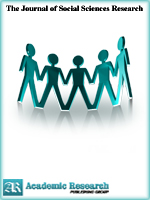The Journal of Social Sciences Research
Online ISSN: 2411-9458
Print ISSN: 2413-6670
Print ISSN: 2413-6670
Quarterly Published (4 Issues Per Year)

Archives
Volume 4 Number 5 May 2018
Secondary School Teachers’ Performances at Sandaran Sub-District of East Kutai District East Kalimantan Indonesia
Authors: Sapril ; Jafar Haruna ; Saraka ; Hasbi Sjamsir
Pages: 80-83
Abstract
Being geographically located in isolation from the Kutai Timur District, has not prevented the school-aged population of Sandaran Sub-District, Kutai Timur District of Indonesia to obtain education services as ruled in by the 1945 Indonesia’ s Constitution, article 31. Purposes of this research are to find out about the teachers’ performances in preparing, implementing and evaluating their teaching-learning process at their secondary schools at Sandaran sub-district, Kutai Timur District, Indonesia. Using the qualitative approach, the data were collected through observation, in-dept interviews towards the secondary school teachers and documentary studies. Conclusions indicated that 1) in preparing their lesson plans, teachers tend to design those that comply with their tertiary qualifications only, not those that they are not qualified in. 2)Implementation of the teaching leaning process has been running well with good discipline enforcement at schools, 3) Evaluation of the teaching-learning process has its own advantages with the application of mid-semester and semester exams resulted in repeatedly intensed learning towards a students’ better independent learning.
Water Scarcity Index Calculation, Atlas Animas, Tecoanapa Municipality, Guerrero, Mexico
Authors: Sirilo Suastegui-Cruz ; Jos? Luis Rosas-Acevedo ; Maximino Reyes-Uma?a ; Am?rica L. Rodr?guez-Herrera ; El?as Hern?ndez-Castro ; Felipe Gallardo L?pez ; Ana Patricia Leyva-Zu?iga
Pages: 74-79
Abstract
Water consumption is a problem, as it is used inefficiently, besides that, the demand is growing much faster than nature can supply, so in the present study an analysis was conducted to determine the amounts of water used in domestic and agricultural activities in a rural town, that allows us to obtain the water shortage index. To define and know the different uses, a survey of people’s perception of household water expenditure is used, both personal hygiene and at home, as well as the use in agricultural activities. Then, the water shortage index is calculated with the model IDEAM (Hydrology, Meteorology and Environmental Studies Institute) modified by Romero and Ortiz (2016), which was adapted to a rural area. The agricultural and domestic activities need 868, 500, 660 L/ha, equivalent to 72.8 % of the total water rains in the study area and, the amount that is not used is 344,982,477 L/ha, what represents the 27.2 % of the total 100 %, the latter is for the recharges of wellsprings to feed the micro-basin, representing problems of water scarcity.



